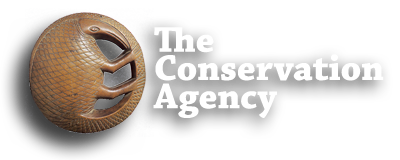In an ongoing effort to preserve and promote biodiversity, TCA scientists are locating and identifying many rare and endangered animals in various habitats around the world, discovering new species and species previously thought to be extinct. Our record of discoveries includes more than 20 new species of mammals, reptiles, and amphibians. Dozens of animals thought to be lost or extinct have been rediscovered, among them Darlington’s Flat Beetle, Walsingham’s Virgin Moth, the spectacular Everett’s Flying Dragon, and the Silver Rice Rat – the latter declared extinct and rediscovered twice. Hundreds of new insect species have been discovered as well. If you would like to be involved in this type of research please contact us. Perhaps you will be joining us on our next expedition! Narragansett Bay Coyote Study (NBCS) – This study of coyotes on Conanicut and Aquidneck Islands has improved the quality of public information about Rhode Island’s coyotes as well as the quality of public outreach through valid scientific sources. Through extensive cooperation with local school systems, steakholder organizations, as well as local and state government, data created by this study will help create Management and Coexistence Strategies for Coyotes on Conanicut and Aquidneck Islands – and now – statewide. Honduras Amphibian Rescue and Conservation Center – HARCC’s goal is to intervene in the spread of an aggressive fungal disease threatening populations of amphibians globally – including the diverse population of Honduran rainforest frogs. Blue Mountain Peak Ranch, Mason, Texas – The passion of TCA VP Richard Taylor on his 830-acre Texas ranch is to increase species diversity and water replenishment of the aquifer. Richard and his restoration team, have accomplished this through dogged invasive species control and prescribed controlled burns, allowing native habitats and wildlife species to repopulate. Management is a long-term commitment and BMBR staff members work with scientists whenever possible to restore valuable facets of the ecosystem. Circuit Biologist Program – The Conservation Agency Circuit Biologist Program provided no-cost consulting for land trusts in Newport County, documenting environmental conditions and making management recommendations concerning native plants, animals, wetlands, habitat corridors, rare species, and invasive exotic species. Turks & Caicos Islands – The Big Ambergris Cay iguana relocation project conducted by the Department of Environment and Coastal Resources, Turks and Caicos Island (TCI), The Conservation Agency (TCA), and the Denver Zoo was a great success. We relocated a total of 404 endangered Turks and Caicos rock iguanas to Long Cay (a government-protected island) after removing a predacious population of feral cats from the island. We monitored the relocated iguanas collecting data on habitat use, burrow location, home range dynamics, and information on reproduction and recruitment of young. Since all Long Cay founders were PIT tagged, and dispersal to the cay was unlikely, we can be reasonably sure that untagged iguanas were born there. In January 2001 we confirmed the presence of Long Cay hatchlings. Survey work a year later resulted in an estimated a population of over 1000 iguanas. The island doubtless supports many more iguanas now. Flamingo Reintroduction to Anegada, BVI – Dr. James (Skip) Lazell first recognized the potential for successful reintroduction of flamingos to the salt ponds of Anegada in the early 1980’s. Cooperating organizations and individuals, including the Bermuda Aquarium Museum and Zoo (BAMZ); Richard Winchell, Mocata Corporation; Dr. Henry Jarecki, the BVI National Parks Trust (NPT) Director; Nick Clark; and others moved a small test group from Bermuda to the small salt pond on Guana Island. The Guana transplant has been successful but the flock is too small to breed. Therefore we got another batch of 18 flamingos and settled them on Anegada in the BVI. This flock attracted four more wild birds and began nesting. By 2007 the Anegada flock had expanded to about 200 flamingos. Details of the story are presented in Lazell’s book, Island – Fact and Theory in Nature. See Publications. Western Hemisphere – The Conservation Agency has supported projects in the Western Hemisphere from Newfoundland to Brazil. In the Canadian Maritimes and New England our subjects have been whales, marine and salt-marsh turtles, vernal pond wildlife, salamanders and acid rain, wetlands protection, and coastal island biogeography. Asia – Since 1980 significant ongoing research has drawn us to the islands of the South China Sea. Here we have discovered many new populations, several new species of land vertebrates, and have documented life histories of threatened species such as Romer’s frog, white-headed blindsnake, and the Chinese pangolin (a scaly ant-eating mammal). We have concentrated efforts on islands in the South China Sea including the geologically ancient island of Nan Ao, in far eastern Guangdong Province, China. On Nan Ao we discovered many populations of species previously known only from inland, upland, and central China. Often these isolated Nan Ao populations are replaced by more tropical relatives on the adjacent mainland. This pattern, dubbed “Austro-boreal disjunction”, is strikingly like that observed in species or subspecies found in the Florida Keys and then again in northern Florida or Georgia. Austro-boreal disjunction has become a topic of great interest in biogeography. Australia and the Pacific – We successfully documented the migratory route of the orange-bellied parrot, extended the known ranges of dozens of species from the red-necked kangaroo to Peripatus insignis (a bizarre primitive invertebrate), and collected life-history data on marsupial carnivores such as swamp antechinus, white-footed dunnart, and quoll. Further, we produced the first-ever demographic study of the Tasmanian devil. On New Caledonia, in the Coral Sea, we have concentrated our efforts on lizards on the offshore islets around Grande Terre, the largest island. We discovered 47 previously undocumented populations, many of rare or little-known species. We added another two dozen significant range extensions for species on the Grande Terre main.


